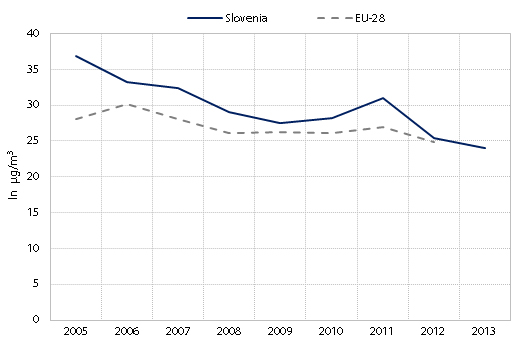ENVIRONMENTAL WELL-BEING – Air
The indicator Urban population exposure to air pollution by particulate matter shows the concentration of particles smaller than 10 µm (PM10), weighted by the number of population potentially exposed to excessive pollution in urban areas. Due to the entry into the respiratory and cardiovascular systems, particles can cause many health problems (asthma, bronchitis, lung damage, cancer) and they also have some negative effects on the environment (acidification and eutrophication of ecosystems). The sources of particles are soil erosion, resuspension from roads and emissions from industrial facilities and combustion installations. The main chemical components of PM10 particles are sulphate and organic material, while in the areas of heavy traffic also a large share of mineral dust is present. Growth of the indicator has a negative impact on well-being.
Figure: Urban population exposure to air pollution by particulate matter, Slovenia and the EU, 2005−2013 (µg/m3)

Source of data: Eurostat, Slovenian Environment Agency.
Note: Average annual limit value should not exceed 40 µg/m
3.
In the past decade air pollution with particulate matter (PM10) has been gradually declining but still a large share of the urban population is exposed to too frequent (more than 35 days per year) excessive concentrations of particles in the air. In most cases, exceeding the daily limit value (over 50 µg/m3) is the result of emissions due to heating related to unfavourable weather conditions, particularly temperature inversion. Such conditions appear in the cold part of the year. Another important source of particulate pollution is traffic, whereas improvement of the state in urban areas is attributed to the construction of treatment plants in industrial facilities.
Results of supplementary indicators show:
Urban population exposure to air pollution by ozone shows that ground level ozone is an important air pollutant in urban areas, and its concentration depends largely on the weather in the summer months. With significant annual variations, in 2012 the concentration remained at roughly the previous-year level and thus high above the EU average.
In 2013, total emissions of substances causing acidification and eutrophication (SOx, NOx and NH3) remained at the previous-year level, while over a longer period they dropped significantly (as they did in the EU), particularly due to the large drop in sulphur dioxide emissions as a result of installing desulphurisation equipment and replacing energy products in electricity and heat generation.
Emissions of ozone precursors (NOx, CO, CH4 and NMVOC) decreased in 2013 by 4% and were thus 21% lower than in 2000 and 45% lower than in 1990. The decrease was the largest in the transport sector, mostly on account of the introduction of stricter emission standards for motor vehicles.
In 2013, emissions of particulate matter smaller than 10 µm (PM10) in Slovenia were 6% below the previous-year level and 17% lower than in 2005. The main source of particulate matter is households, particularly due to the use of wood biomass for heating; other important factors are agriculture and transport.
